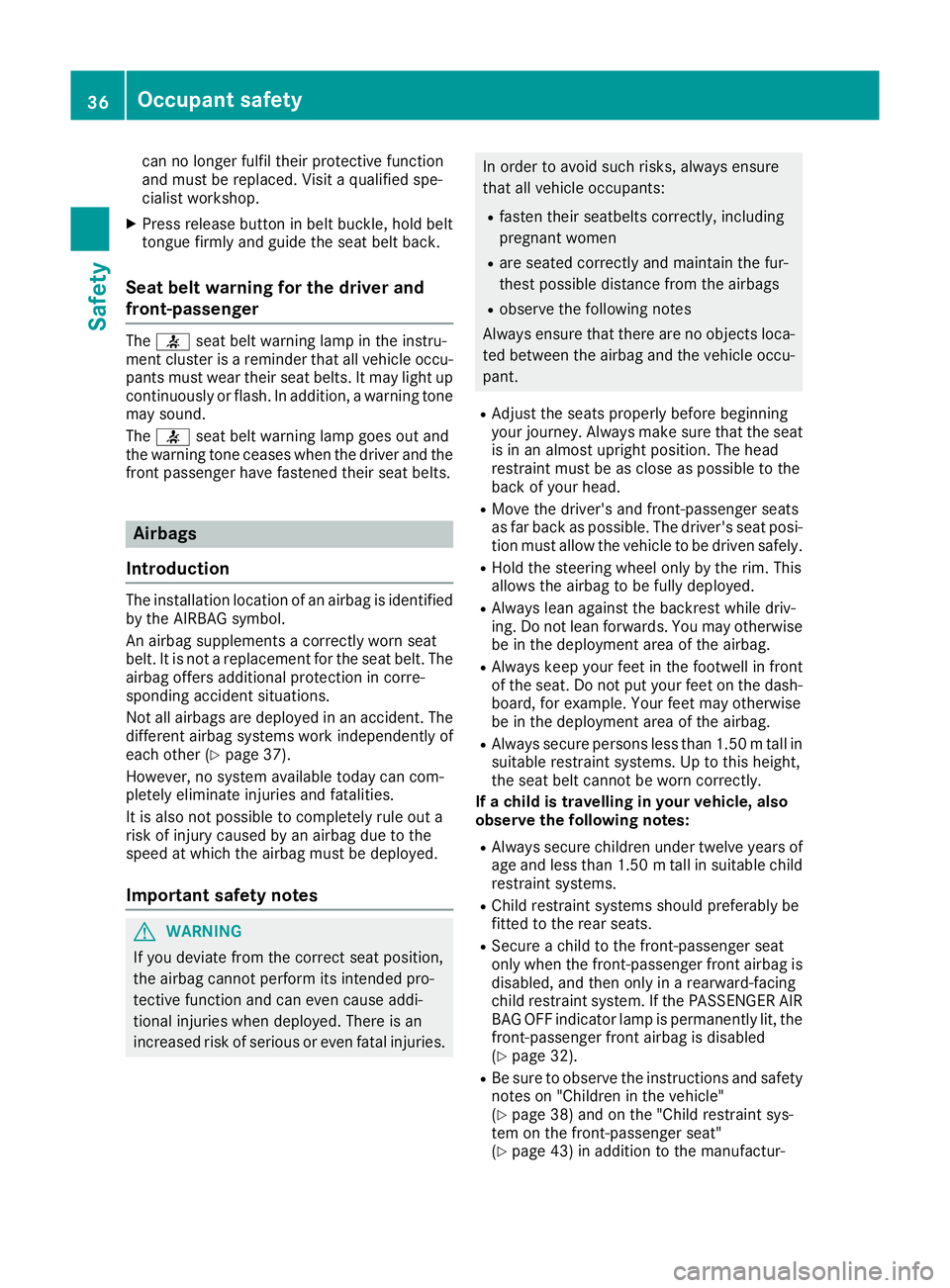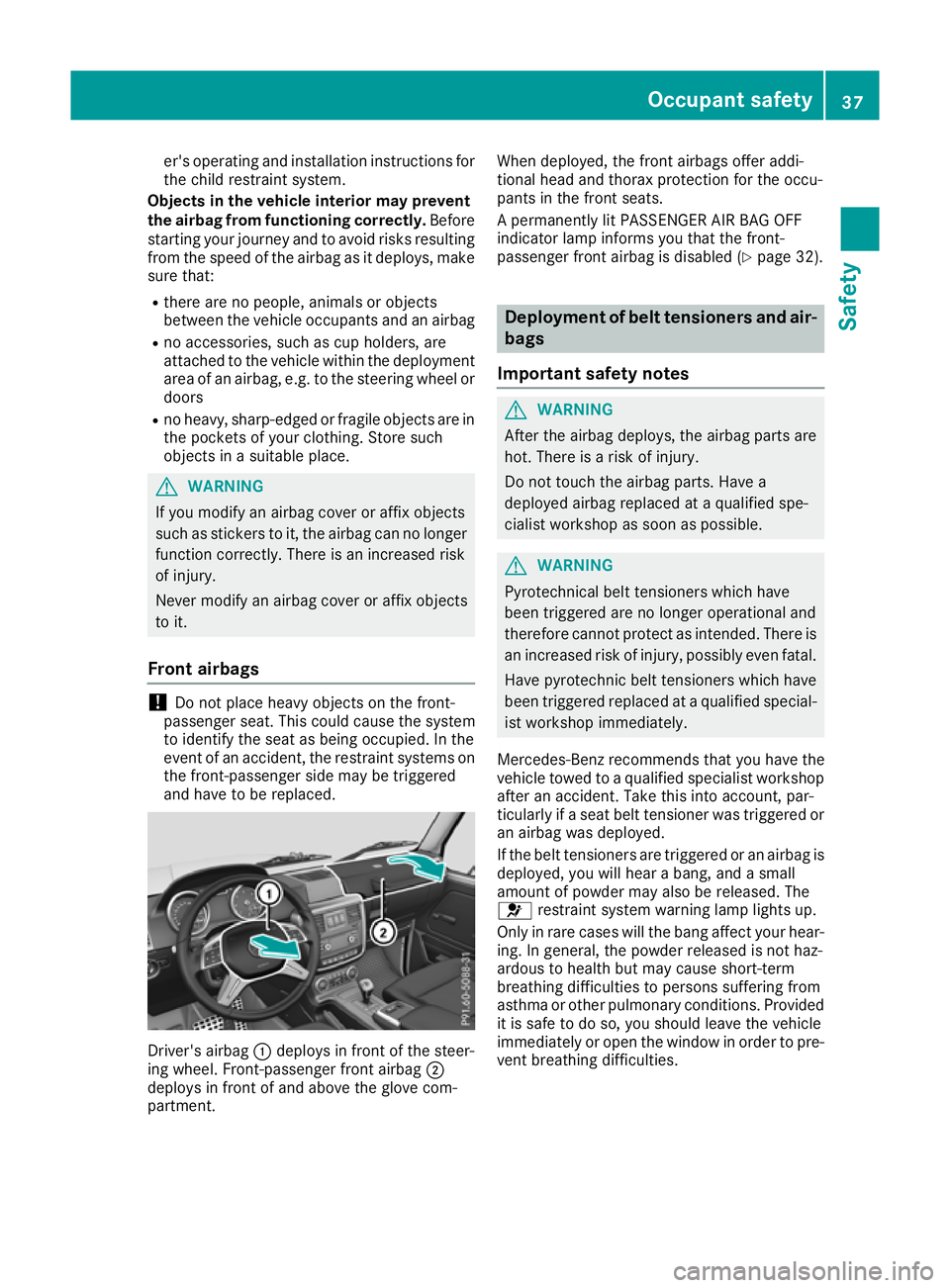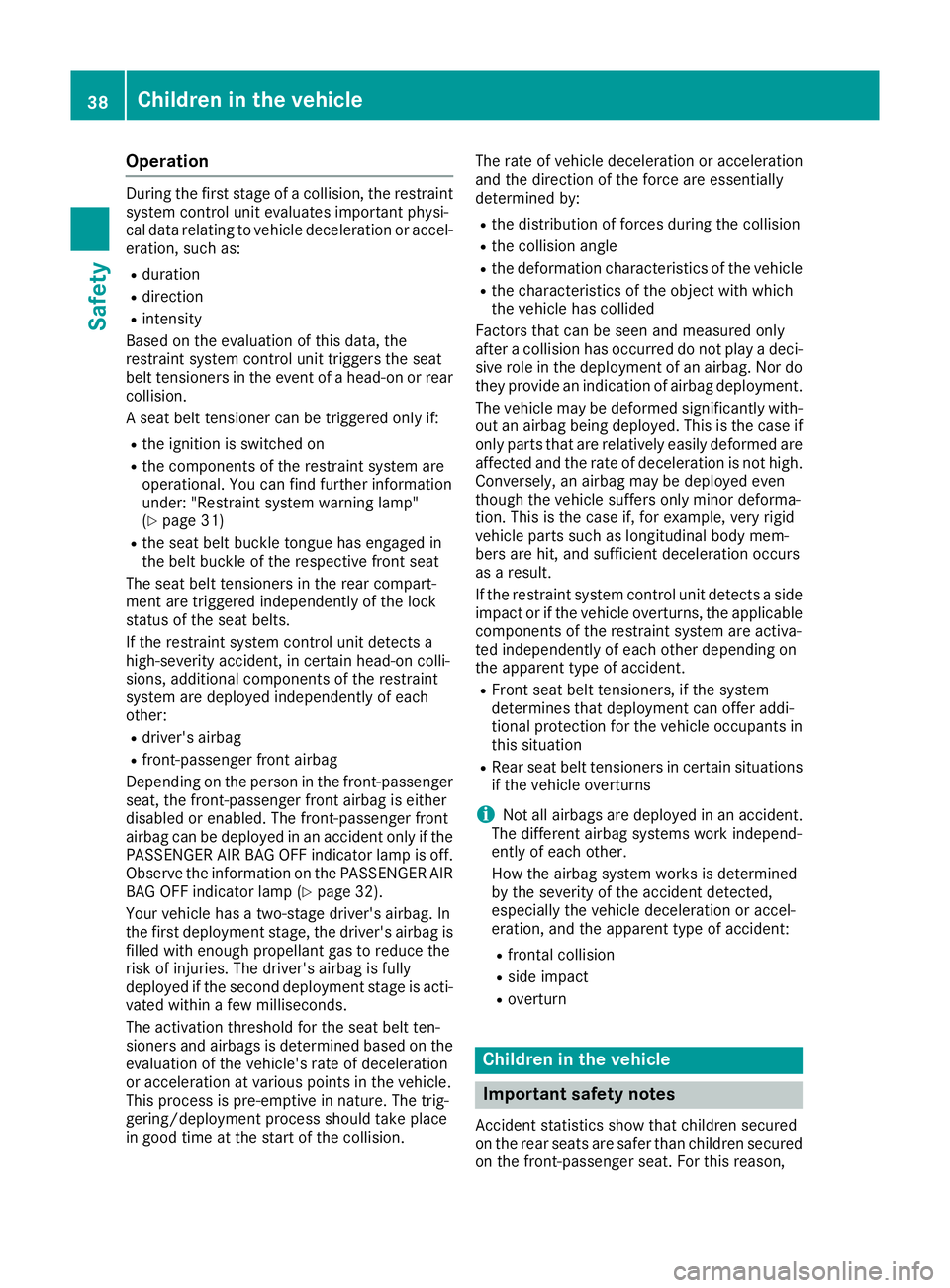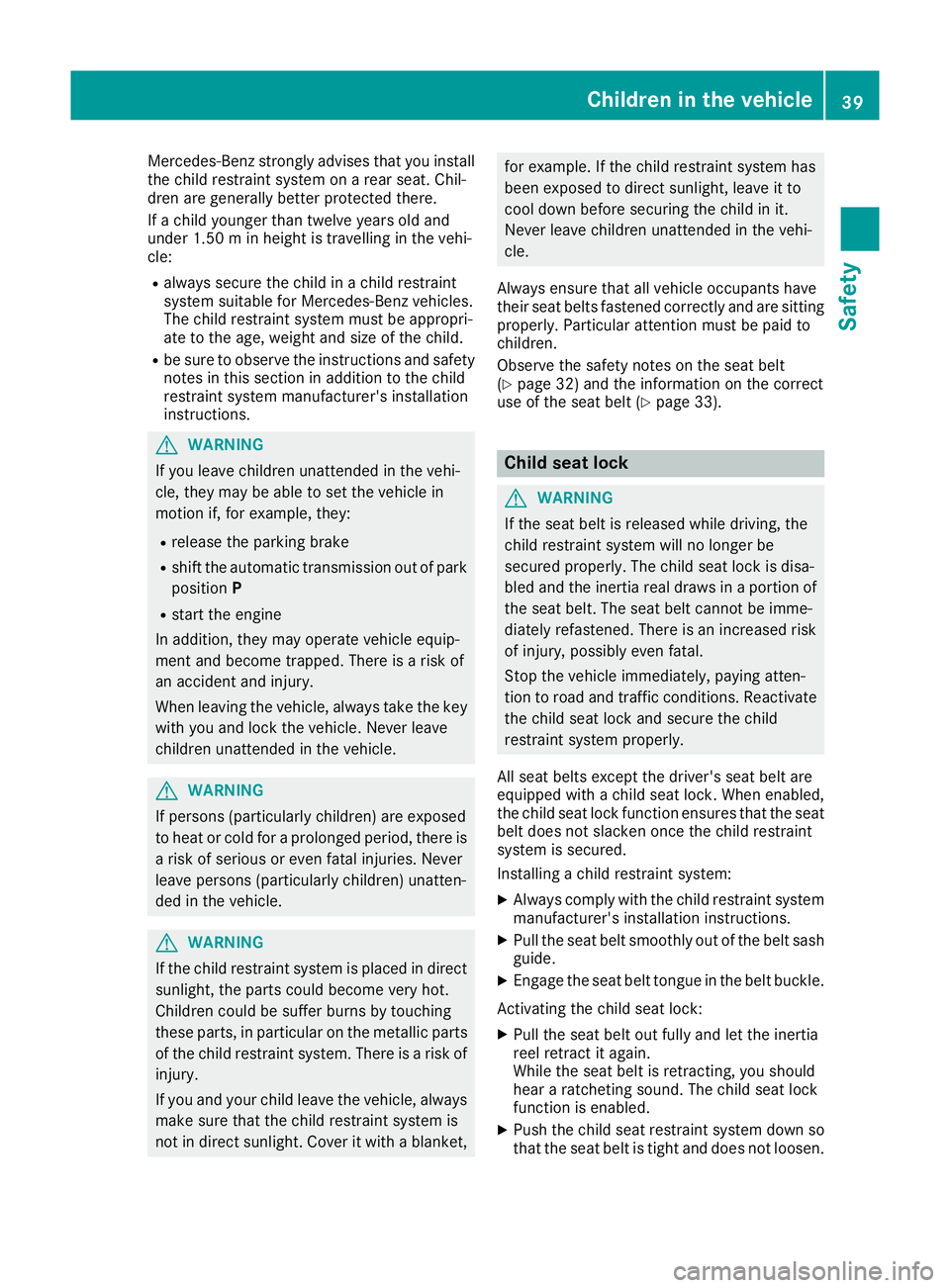2016 MERCEDES-BENZ G-CLASS SUV belt
[x] Cancel search: beltPage 37 of 261

R
the shoulde rsectio noft he belt is routed
across the centr eofthe shoulder
The shoulde rsectio noft he seat belt should
not touch your neck or be routed under your
ar morb ehindyourb ack.
R the la pbeltist auta nd passe sacross the lap
as lo wdownasp ossible
The la pbeltm usta lway sber outed across
your hi pjoints and neve racross your abdo-
men. Thi sapplies particularly to pregnant
women. If necessary ,press the la pbeltd own
into your hi pjoints and pull tight with the
shoulde rsectio noft he belt.
R the seat belt is not routed across sharp, poin-
ted or fragile objects
If yo uhaves uchi tems locate donorinyour
clothing, e.g .pens, key sorspectacles, store
these in asuitabl eplace.
R onl yone perso nisu sing aseatb elt
Infants and children must neve rtravel sitting
on the la pofavehicleoccupant. In the event
of an accident, the ycould be crushed
between the vehicl eoccupant and seat belt.
R objects ar eneve rsecured with aseatb eltif
the seat belt is also being used by one of the vehicle' soccupants
Als oe nsur ethatnoo bjects ar eplaced
between aperso na nd the seat. e.g .acush-
ion.
Sea tbelts ar eintende donlytos ecurea nd
restrain vehicl eoccupants. Alway sobser ve the
"Loading guidelines" for securing objects ,lug-
gage or load s(Ypage 198).
Faste nthe seat belts Observ
ethe safety notes on the seat belt
(Y page 32) and the information on the correct
use of the seat belt (Y page 33).
If ap assenger is wearing the centrer ear seat
belt, also observe the information on the seat
belt for the centrer ear seat (Ypage 34). Basic illustration
X Adjust the seat (Y page 67).
The seat backrest must be in an almost
upright position.
X Pull the seat belt smoothly out of belt sash
guide =and engage belt tongue ;into belt
buckle :.
X If necessary ,pullu pward sonthe sea tbeltin
front of your chest so that the bel tsits tightly
across your body.
All sea tbelts in the vehicle with the exception of
the driver's sea tbelta re equipped with achild
sea tlock, to which achildr estraint system can
be secured. You can find further information
unde r"Ch ilds eatlock" (Y page 39).
Sea tbeltf or the centre rear seat G
WARNING
When the three-point seat bel tfor the centre
rear seat is not in use, it may be thrown
around while driving, e.g. when braking or in
an accident. There is arisk of injury.
When the three-point seat beltf or the centre
rear seat is not in use, alwayss ecure both belt
buckle tongues in the retainer. 34
Occupant safetySafety
Page 38 of 261

:
Retainer for seat belt tongues
; Beltbuckle for fixed belt tongue
= Releas ebutto nfor fixed belt tongue
? Fixed belt tongue
A Beltbuckle for movable belt tongue
B Releas ebutto nfor movable belt tongue
C Movable belt tongue X
Pull both seat belt tongues ?and Cfrom
retainer :. X
Pull the seat belt smoothly from the belt outlet
and engage fixe dbelt tongue ?in belt
buckle ;. X
To fasten the seat belt: pull the seat belt
smoothly fro mthe belt outle tand engage
movabl ebeltt ongue Cin belt buckle A.
X If necessary ,pullu pwar ds on the shoulder
section of the sea tbelttot ighten the belt
across your body.
Releasin gseatb elts !
Mak
esure that the seat belt is fully rolled up.
Otherwise, the seat belt or belt tongue will be
trapped in the door or in the seat mechanism. This could damage the door, the door trim
panel and the seat belt. Damaged seat belts Occupant safety
35Safety Z
Page 39 of 261

can no longer fulfil thei
rprotective function
and mus tbereplaced. Visit aquali fied spe-
cialist workshop.
X Press release button in bel tbuckle, hol dbelt
tongu efirmly and guid ethe sea tbeltb ack.
Seat belt warnin gfor the drive rand
front-passenger The
7 seatbelt warning lamp in the instru-
ment cluster is areminder that all vehicle occu-
pants must wear their seat belts. It may light up
continuously or flash. In addition, awarning tone
may sound.
The 7 seat belt warning lamp goes out and
the warning tonec eases when the driver and the
front passenger have fastened their seat belts. Airbags
Introduction The installation location of an airbag is identified
by the AIRBA Gsymbol.
An airbag supplements acorrectly worn seat
belt. It is not areplacement for the seat belt. The
airbag offers additional protection in corre-
sponding accident situations.
Not all airbags are deployed in an accident .The
different airbag systems work independently of
each other (Y page 37).
However, no system availabl etoday can com-
pletely eliminate injuries and fatalities.
It is also not possible to completely rule out a
risk of injury caused by an airbag due to the
speed at which the airbag must be deployed.
Important safety notes G
WARNING
If you deviate from the correct seat position,
the airbag canno tperform its intended pro-
tective function and can even caus eaddi-
tional injurie swhen deployed. There is an
increased risk of serious or even fatal injuries. In order to avoid such risks, always ensure
that all vehicle occupants:
R fasten their seatbelts correctly, including
pregnant women
R are seated correctly and maintain the fur-
thest possible distance from the airbags
R observe the following notes
Alway sensure that there are no objects loca-
ted betwee nthe airbag and the vehicle occu-
pant.
R Adjust the seats properl ybefore beginning
yourj ourney. Alwaysm ake sure that the seat
is in an almostu pright position. The head
restraint must be as close as possible to the
back of yourh ead.
R Move the driver's and front-passenger seats
as far back as possible. The driver's seat posi- tion must allow the vehicle to be driven safely.
R Hold the steering wheel only by the rim. This
allows the airbag to be fullyd eployed.
R Alwaysl eana gainst the backrest whiled riv-
ing. Do not leanf orwards. You may otherwise
be in the deployment area of the airbag.
R Alwaysk eep yourf eet in the footwell in front
of the seat. Do not put yourf eet on the dash-
board,f or example .Your feet may otherwise
be in the deployment area of the airbag.
R Alwayss ecure persons less than 1.50 mtall in
suitable restraint systems .Uptothish eight,
th es eat belt canno tbeworn correctly.
If ac hild is travelling in your vehicle, also
observe th efollowin gnotes:
R Always secure childre nunde rtwelve years of
age and less than 1.50 mtall in suitable child
restraint systems.
R Child restraint systems shoul dpreferabl ybe
fitte dtot herear seats.
R Secure achild to th efront-pa ssenger seat
only when th efront-pa ssenger fron tairbag is
disabled, and then only in arearward-facing
child restraint system. If th ePASSENG ER AIR
BA GO FFindicator lamp is permanently lit ,the
front-passenger fron tairbag is disabled
(Y page 32).
R Be sure to observ ethe instruction sand safety
note son" Children in th evehicle"
(Y page 38 )and on th e"Child restraint sys-
te mont hefront-passenger seat"
(Y page 43 )inaddition to th emanufactur- 36
Occupant safetySafety
Page 40 of 261

er's operatin
gand installation instructions for
the child restraint system.
Objects in the vehicle interior may prevent
the airba gfrom functioning correctly. Before
starting your journey and to avoid risks resulting from the speed of the airbag as it deploys, make
sure that:
R there are no people, animals or objects
between the vehicle occupant sand an airbag
R no accessories, such as cup holders, are
attached to the vehicle within the deployment
area of an airbag, e.g. to the steerin gwheel or
doors
R no heavy, sharp-edged or fragile objects are in
the pockets of your clothing. Store such
objects in asuitable place. G
WARNING
If you modify an airbag cove roraffix objects
such as stickers to it, the airbag can no longer function correctly. There is an increased risk
of injury.
Never modify an airbag cover or affix objects
to it.
Fron tairbags !
Do not place heavy objects on the front-
passenger seat. This could cause the system
to identif ythe seat as being occupied. In the
event of an accident, the restraint systems on the front-passenger side may be triggered
and have to be replaced. Driver's airbag
:deploysinf ront of the steer-
ing wheel. Front-passenge rfront airbag ;
deploy sinfront of and above the glove com-
partment. When deployed
,the fron tairbags offer addi-
tional head and thorax protection for the occu-
pants in the fron tseats.
Ap ermanently lit PASSENGE RAIR BAG OFF
indicator lamp inform syou that the front-
passenger fron tairbag is disabled (Y page 32). Deployment of beltt
ensioner sand air-
bags
Important safet ynotes G
WARNING
Afte rthe airbag deploys, the airbag parts are
hot. There is arisk of injury.
Do not touch the airbag parts. Have a
deployeda irbag replaced at aqualified spe-
cialist worksho passoon as possible. G
WARNING
Pyrotechnical beltt ensioners which have
been triggere dare no longer operational and
therefore cannot protect as intended. There is an increased risk of injury ,possibly even fatal.
Have pyrotechnic beltt ensioners which have
been triggere dreplaced at aqualified special-
ist worksho pimmediately.
Mercedes-Benz recommends that you have the
vehicl etowed to aqualified specialist workshop
after an accident. Take this into account, par-
ticularly if aseat beltt ensioner was triggere dor
an airbag was deployed.
If the beltt ensioners are triggere doranairbag is
deployed, you willh earabang, and asmall
amount of powder may alsober eleased.The
6 restraint system warning lamp lights up.
Only in rare cases willt he bang affect yourhear-
ing. In general, the powder released is not haz-
ardous to health but may caus eshort-term
breathing difficultie stopersons suffering from
asthma or other pulmonary conditions. Provided it is safe to do so, you should leave the vehicle
immediatel yoropen the windo winorder to pre-
vent breathing difficulties. Occupant safety
37Safety Z
Page 41 of 261

Operation
During th
efirst stage of acollision, the restraint
system contro lunite valuate simportant physi-
cal data relating to vehicl edeceleratio noraccel-
eration, such as:
R duration
R direction
R intensity
Based on the evaluation of thi sdata, the
restraint system contro lunitt riggers the seat
belt tensioners in the event of ahead-o norrear
collision.
As eatb eltt ensioner can be triggered onl yif:
R the ignition is switched on
R the components of the restraint system are
operational .You can find furthe rinformation
under: "Restraint system warning lamp"
(Y page 31)
R the sea tbeltb uckle tongue ha sengaged in
the belt buckle of the respectiv efront seat
The sea tbeltt ensioners in the rea rcompart-
ment ar etriggered independentl yofthe lock
status of the sea tbelts.
If the restraint system contro lunitd etects a
high-severity accident, in certain head-on colli-
sions, additional components of the restraint
system ar edeployed independentl yofeach
other:
R driver's airbag
R front-passenge rfront airbag
Depending on the perso ninthe front-passenger
seat, the front-passenge rfront airba giseither
disabled or enabled .The front-passenge rfront
airba gcan be deployed in an accident onl yifthe
PASSENGER AIR BAG OFF indicator lamp is off.
Observe the informatio nonthe PASSENGER AIR
BAG OFF indicator lamp (Y page 32).
Your vehicl ehasatwo-stage driver's airbag. In
the first deployment stage ,the driver's airba gis
fille dwithe noug hpropellant ga storeduce the
ris kofi njuries. The driver's airba gisfully
deployed if the second deployment stage is acti- vated withi nafew milliseconds.
The activatio nthreshold for the sea tbeltt en-
sioners and airbags is determine dbased on the
evaluation of the vehicle's rate of deceleration
or acceleratio natvarious points in the vehicle.
Thi sp roces sispre-emptive in nature. The trig-
gering/deployment proces sshoul dtake place
in good time at the start of the collision. Th
er ate of vehicle deceleration or acceleration
and the direction of the force are essentially
determined by:
R the distribution of forces during the collision
R the collision angle
R the deformation characteristics of the vehicle
R the characteristics of the object with which
the vehicle has collided
Factors that can be seen and measured only
after acollision has occurred do not play adeci-
sive role in the deployment of an airbag. Nor do
they provide an indication of airbag deployment.
The vehicle may be deformed significantly with-
out an airbag being deployed. This is the case if only parts that are relatively easily deformed are
affected and the rate of deceleration is not high. Conversely, an airbag may be deployed even
though the vehicle suffers only minor deforma-
tion. This is the case if, for example, very rigid
vehicle parts such as longitudinal body mem-
bers are hit, and sufficient deceleration occurs
as aresult.
If the restraint system control unit detect saside
impact or if the vehicle overturns, the applicable components of the restraint system are activa-
ted independently of each other depending on
the apparent type of accident.
R Fronts eat belt tensioners, if the system
determines that deployment can offer addi-
tional protection for the vehicle occupant sin
this situation
R Rear seat belt tensioners in certain situations
if the vehicle overturns
i Not all airbags are deployed in an accident.
The different airbag systems work independ-
ently of each other.
How the airbag system works is determined
by the severity of the accident detected,
especially the vehicle deceleration or accel-
eration, and the apparent type of accident:
R frontal collision
R side impact
R overturn Childr
en in th evehicle Important safety notes
Acciden tstatistics sho wthatc hildren secured
on th erear seat sare safer than children secured
on th efront-pa ssenger seat .For this reason, 38
Children in th
evehicleSafety
Page 42 of 261

Mercedes-Ben
zstrongly advises that you install
the child restraint system on arear seat. Chil-
dren are generally better protected there.
If ac hild younger than twelve years old and
under 1.50 minh eight is travellin ginthe vehi-
cle:
R always secur ethe child in achild restraint
system suitable for Mercedes-Ben zvehicles.
The child restraint system must be appropri-
ate to the age, weight and size of the child.
R be sure to observe the instructions and safety
notes in this section in addition to the child
restraint system manufacturer' sinstallation
instructions. G
WARNING
If you leave children unattende dint he vehi-
cle, they may be abletos et the vehiclein
motion if, for example, they:
R release the parking brake
R shift the automatic transmission out of park
position P
R start the engine
In addition, they may operate vehicl eequip-
ment and become trapped. There is arisk of
an accident and injury.
When leaving the vehicle, alwayst ake the key
with you and lock the vehicle. Never leave
children unattended in the vehicle. G
WARNING
If persons (particularly children) are exposed
to heatorc old foraprolonged period, there is
ar isk of serious or even fatal injuries. Never
leave persons (particularly children) unatten-
ded in the vehicle. G
WARNING
If the child restraint system is placed in direct sunlight, the parts coul dbecome very hot.
Childre ncouldbes uffer burns by touching
these parts, in particular on the metallic parts
of the child restraint system. There is arisk of
injury.
If you and yourc hild leave the vehicle, always
make sure that the child restraint system is
not in direct sunlight. Cove ritwithablanket, for example. If the child restraint system has
been expose
dtodirect sunlight, leave it to
cool dow nbefore securing the child in it.
Never leave children unattende dinthe vehi-
cle.
Always ensure that all vehicl eoccupants have
their sea tbelts fastened correctly and are sitting
properly .Particular attention must be pai dto
children.
Observ ethe safety notes on the sea tbelt
(Y pag e32) and the information on the correct
use of the sea tbelt( Y pag e33). Chil
dseat lock G
WARNING
If th eseat beltisr eleased while driving, the
child restraint system willnol onger be
secure dproperly.T he child seat lock is disa-
bleda nd the inertia real draw sinaportion of
the seat belt. The seat beltc annot be imme-
diately refastened. There is an increased risk
of injury ,possibly even fatal.
Stop the vehicl eimmediately, paying atten-
tion to road and traffic conditions. Reactivate the child seat lock and secure the child
restraint system properly.
All seat belts except the driver's seat belta re
equipped with achild seat lock. When enabled,
the child seat lock function ensure sthat the seat
beltd oes not slacken once the child restraint
system is secured.
Installing achild restraint system:
X Always comply with the child restraint system
manufacturer's installation instructions.
X Pullt he seat belts moothly out of the belts ash
guide.
X Engage the seat beltt ongue in the beltbuckle.
Activating the child seat lock: X Pullt he seat belto ut fullyand let the inertia
reel retract it again.
Whil ethe seat beltisr etracting, you should
hear aratcheting sound .The child seat lock
function is enabled.
X Push the child seat restraint system downso
that the seat beltist ight and does not loosen. Children in the vehicle
39Safety Z
Page 43 of 261

Removin
gachild restrain tsystem and deacti-
vating th echild seat lock:
X Always comply wit hthe child restrain tsystem
manufacturer' sinstallation instructions.
X Press th erelease butto nofthebelt buckle,
hold th ebelt tongue firmly and guide it back
towards th ebelt sash guide.
The child seat loc kfunction is deactivated. Child restraint system
Observ ethe instruction sfor correc tuse of the
child restraint system (Y page 46).
For safety reasons, Mercedes-Ben zrecom-
mends that you use only achild restraint system
recommended by Mercedes-Benz
(Y page 49). G
WARNING
If th echild restraint system is incorrectly fit-
ted on the seat position suitable for this pur-
pose ,itcannot perform its intended protec-
tive function. In the event of an accident,
sharp braking or asudden change in direction,
the child may not be held securely.T here is an
increased risk of serious or even fatal injuries.
Observe the manufacturer's installation
instructions and the correct use for the child
restraint system. Make sure that the entire
surface of the child restraint system is resting
on the seat surface. Never place objects
under or behind the child restraint system,
e.g. cushions. Only use child restraint sys-
tems with the original cover designed for
them. Only replace damaged covers with gen- uine covers. G
WARNING
If the child restraint system is fitted incor-
rectly or is not secured, it can come loos ein
the event of an accident, heavy braking or a
sudden change in direction. The child
restraint system coul dbethrown about, strik-
ing vehicl eoccupants. There is an increased
risk of injury ,possibly even fatal.
Always fit child restraint systems properly,
even if they are not being used .Make sure that you observe the child restraint system
manufacturer's installation instructions.
Further information on stowing objects, luggage and load ssecurel ycan be found under "Loading
guidelines" (Y page 198). G
WARNING
Child restraint systems or thei rsecuring sys-
tems that have been damaged or subjected to al oa dinana ccident cannot perform their
intended protective function. In the event of
an accident, sharp braking or asudden
change in direction, the child may not be held securely.T here is an increased risk of serious
or even fatal injuries.
Immediately replace child restraint systems
that have been damaged or subjected to a
loadinana ccident. Have the child restraint
securing systems checked in aqualified spe-
cialist worksho pbefore fitting achild restraint
system again.
The securing systems of child restraint systems
are:
R the seat belts ystem
R the ISOFIX securing rings
R the Top Tether anchorages
If circumstances require you to fit achild
restraint system to the front-passenge rseat, be
sure to observe the information on "Child
restraint systems on the front-passenge rseat"
(Y page4 3). Information on disabling the
front-passenge rfront airbag can alsobef ound
there.
Observe the warning labels in the vehicl einte-
rior and on the child restraint system.
i It is advisabl
etouse Mercedes-Benz care
products to clea nchild restraint systems rec-
ommended by Mercedes-Benz. Information
can be obtained at aqualified specialist work-
shop. ISOFIX chil
dseat securing system G
WARNING
ISOFIX chil drestraint systems do not offer
sufficient protective effect for children whose 40
Children in the vehicleSafety
Page 44 of 261

weight is greater than 22 kg who are secured
using th esafet ybelt integrated in th echild
restrain tsystem. The chil dcould, for example,
not be restrained correctly in th eeven tofan
accident. This poses an increase drisk of
injury or even fatal injury.
If th echildw eighs mor ethan2 2kg,only use
ISOFI Xchildr estrain tsystems with which the
chil disa lso secured with th evehicle seat belt.
Als osecure th echildr estrain tsystem with the
Top Tether belt ,ifavailable.
When fittin gachildr estrain tsystem, be sure to
observe th emanufacturer's installation and
operatin ginstructions and th einstructions for
correc tuse of th echildr estrain tsystem
(Y page 46).
Before ever ytrip, mak esure that th eISO FIX
chil drestrain tsystem is engaged correctly in
bot hISO FIXs ecurin grings.
! When fittin
gthe chil drestrain tsystem,
mak esure that th eseat belt for th ecentre
seat does not get trapped. Otherwise, the
seat belt could be damaged. X
Instal lthe ISOFIX child restraint system on
both ISOFIX securing rings :.
ISOFIX is astandardised securing system for
specially designed child restraint systems on
the rear seats. The ISOFIX securing rings for two ISOFIX child restraint systems are fitted on the
left and right of the rear seats.
Non-ISOFIX child seats may also be used and
can be installe dusing the vehicle's seat belt
system. When fitting achild restraint system, be
sure to observe the manufacturer's installation
and operating instructions and the instructions
for correct use of the child restraint system
(Y page 46). Top Tether
Introduction Top Tether provides an additional connection
betwee nthe child restraint system secured with
ISOFIX and the vehicle. It helps reduce the risk
of injury even further. If the child restraint sys-
tem is fitted with aTop Tether belt, this should
alway sbeu sed.
Important safety notes G
WARNING
If the rear seat backrests are not locked, they
could fold forwards in the event of an acci-
dent, heavy braking or sudden changes of
direction .Asaresult, child restraint systems
cannot perform their intended protective
function. Rears eat backrests that are not
locked can alsoc auseadditiona linjuries, e.g.
in the event of an accident. This poses an
increased risk of injury or even fatal injury.
Always lock rear seat backrests after fitting a Top Tether belt. Adjust the rear seat backr-
ests so that they are positioned upright.
Make sure that the backrest in the rear com-
partment engages fully. To do so, pullf irmly on
the seat backrest.
Top Tether anchorages Top Tethe
ranchorages ;are on the luggage
compartment floor. Children in the vehicle
41Safety Z